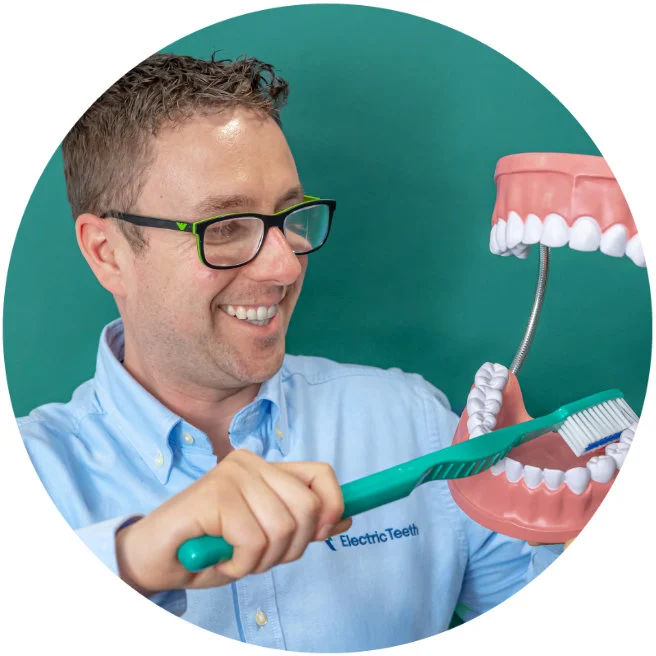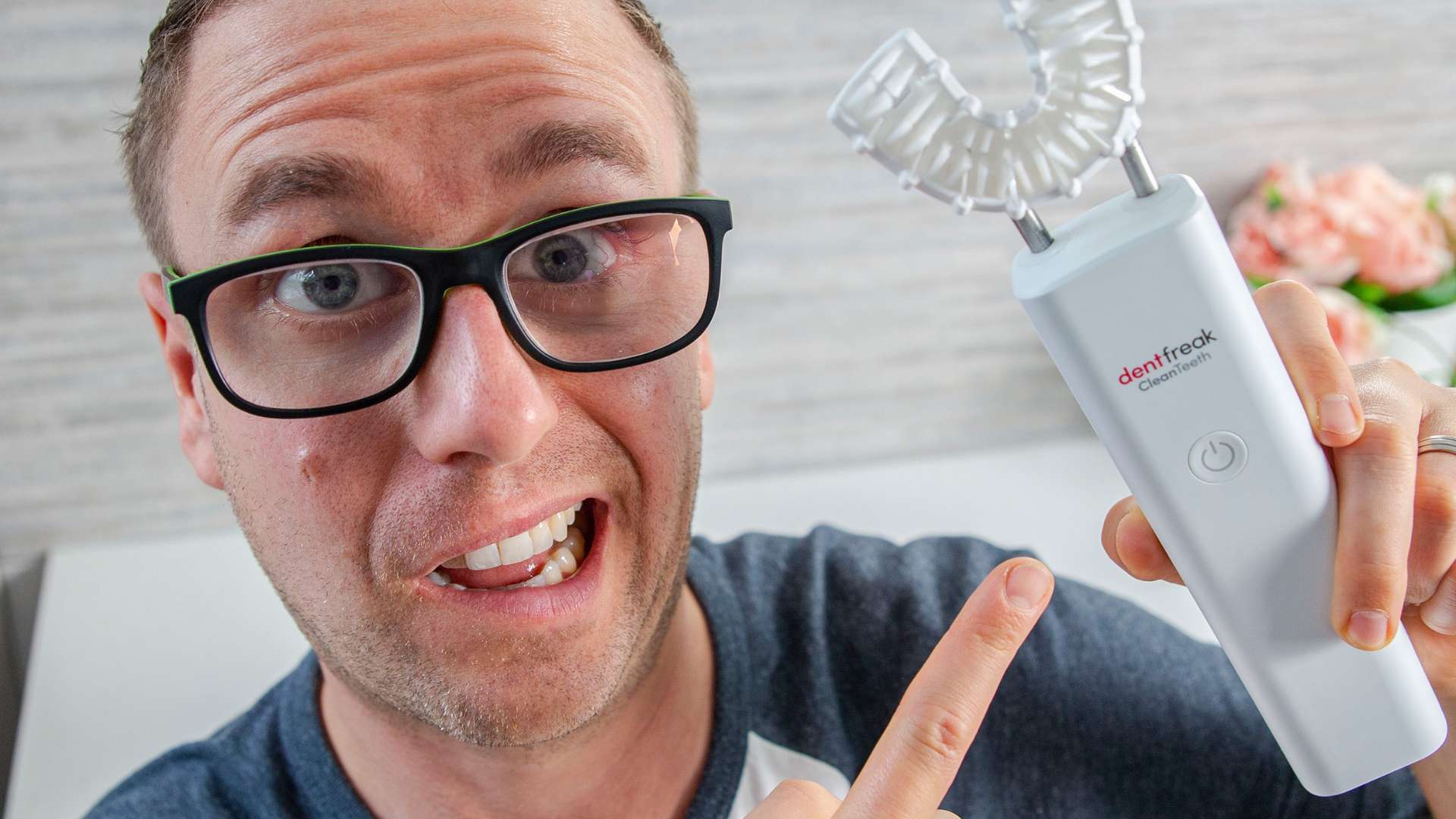
Editor's note
October 2023: CleanTeeth is now called Samba, having been acquired by Curaprox.
It now has a smaller brush head and is being marketed towards those with disabilities, for whom regular toothbrushing is more challenging.
It can still be used by the general public, it hasn't become a product that is specialised to only those with disabilities.
Our review below is of the original CleanTeeth product. We have not tested the new smaller brush head. The experience and result might well have changed for the better.
More information can be found at www.samba.us.
Electric Teeth backed CleanTeeth through Kickstarter. We did receive an early final sample ahead of other backers. Our unit is configured for 15 second brushing sessions per arch. All backers and new purchasers will receive a unit that offers 22 second brushing sessions per arch.
It can make brushing quicker & easier, but it's an expensive option
CleanTeeth is one of the better mouthpiece toothbrush options.
Brushing results are good, but it leaves plaque in areas that it shouldn’t. A regular toothbrush remains the gold standard.
It is clear that it overcomes some of the weaknesses of comparable products. But, right now there are other brushes that I would choose over CleanTeeth.
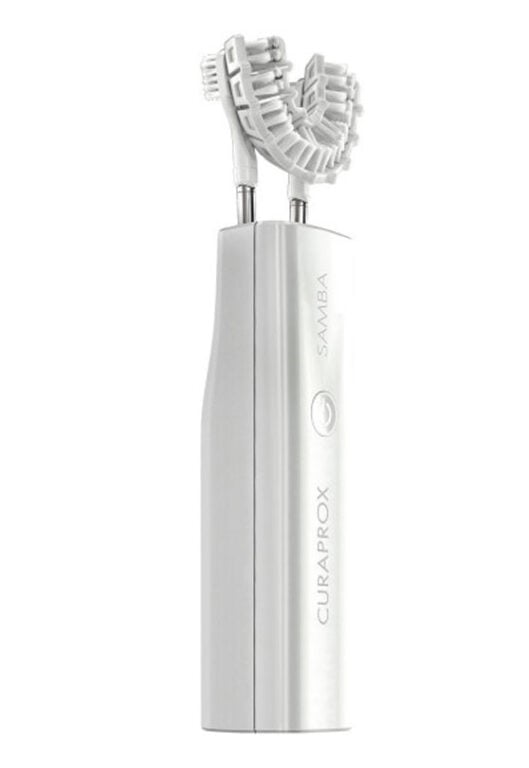
Pros |
Cons |
|---|---|

Surprisingly good cleaning results |
Cleaning results are not good enough – some important areas are missed |

Flexible mouthpiece |
In use, the movement causes your head to shake quite a bit |

Built-in timer |
The handpiece is bulky and heavy |

Long battery life |
It’s expensive |
Consider these other brushes
Symplbrush is the best alternative to CleanTeeth, if you want a mouthpiece style toothbrush.
But, the optimum brushing results will be achieved using a regular electric toothbrush, our choice being the Oral-B Smart 1500.
The small round brush head reaches into some of the tightest spots in the mouth and delivery a satisfying clean, whilst costing a fraction of the cost.

How CleanTeeth looks, feels and works
Before getting into all the details of the CleanTeeth toothbrush itself, I feel it appropriate to give a bit more context to why CleanTeeth even exists and how it differs.
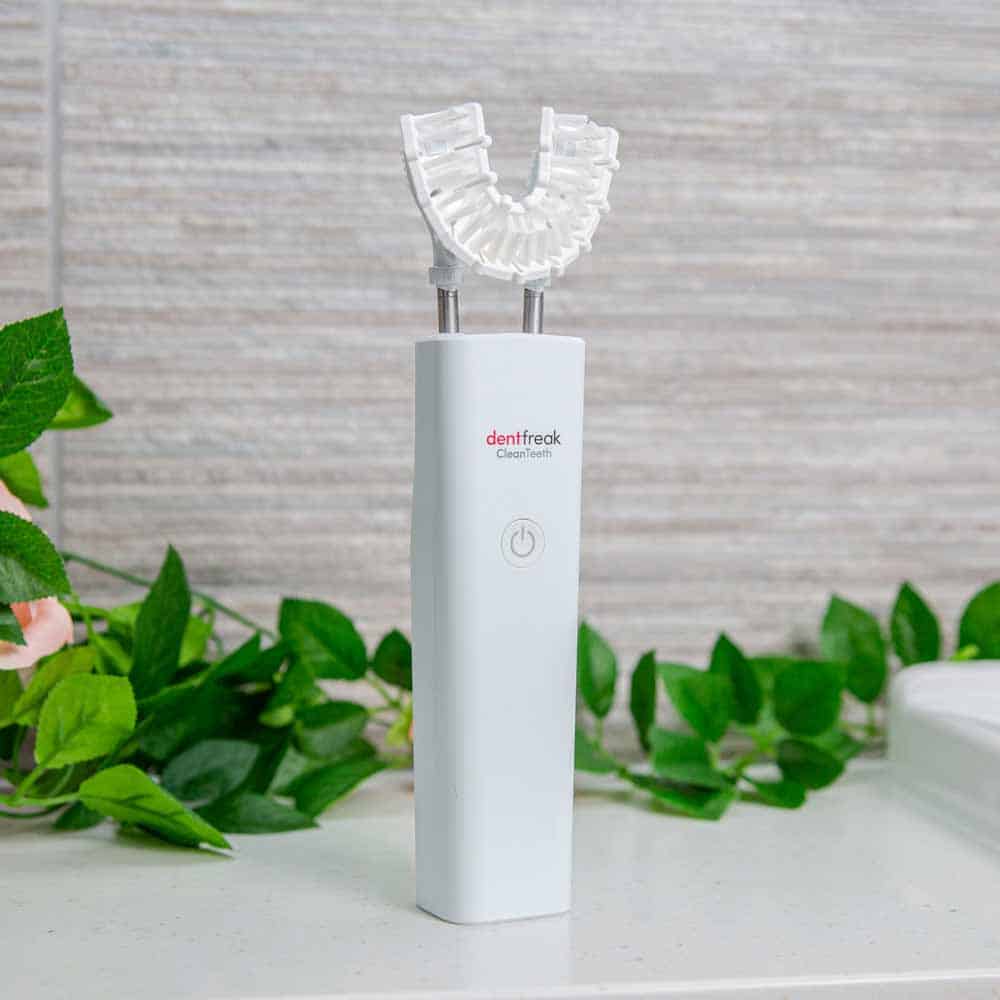
The idea behind CleanTeeth
No doubt you can tell by just looking at CleanTeeth, that this isn’t your regular toothbrush found in stores and in homes across the country.
It is very much a part of a new wave of oral care products looking to reshape the industry.
It is, for lack of a better name, a mouthpiece toothbrush.
To understand why such a product exists, we first need to understand what a good oral care routine looks like. It isn’t as complex as you might think.
We advocate that you do the following to achieve a healthy smile:
- Brush your teeth twice a day with a fluoride toothpaste
- Brush for 2 minutes each time
- Use the correct brushing technique
- Spit after brushing, don’t rinse with mouthwash or water
- Clean between the teeth once a day, with interdental brushes (floss or water flossers are an alternative)
If you’re willing to brush for two minutes, twice daily, existing products like the regular toothbrush are hard to beat.
But, the reality is few do. Thus their oral health suffers.
Statistics show that on average people are brushing for just 45-70 seconds per day. And we know that many are not following the other steps in this routine.
A large proportion of a dentist’s day can be spent fixing the consequences of brushing too hard, or not brushing long enough.
The concept with DentFreaks toothbrush is to take away some of the challenges that lie with the user. Positioning the bristles at the perfect angle within the mouthpiece means the user doesn’t have to. Cleaning all 3 surfaces of the teeth at the same time reduces the total brushing time.
And because most users do at least spend some time brushing each day, CleanTeeth can achieve more in less time and make improvements for those that don’t have the best routine.
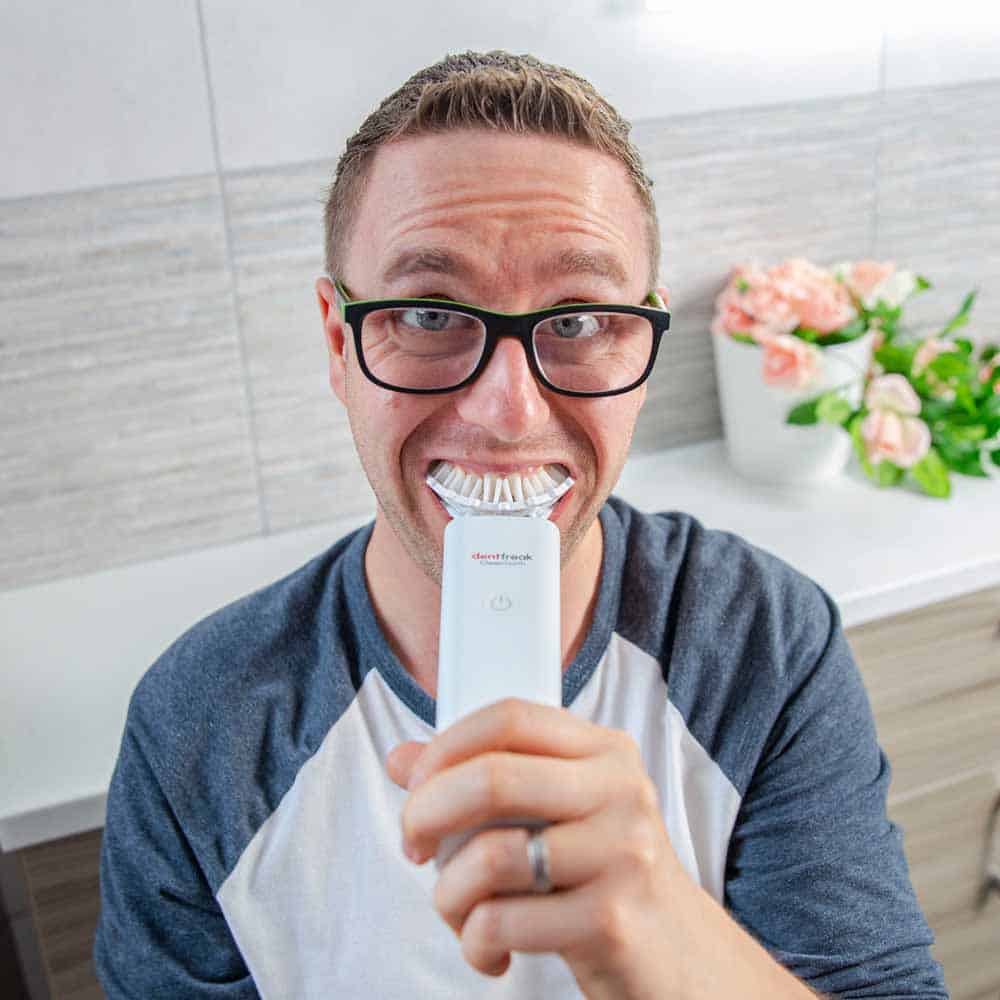
44 seconds rather than 120
The average adult has 32 teeth.
Each has 3 sides.
That is 96 surfaces in total. (28 teeth or 84 surfaces if you don’t have the wisdom teeth)
Therefore with a dentist recommended 2 minute (120 second) cleaning, each surface gets brushed for just 1.25 seconds.
When a brush head is covering all 3 surfaces at one time, you can essentially reduce the total brushing time by a third. That would be 40 seconds, but CleanTeeth has gone for 44!
In theory, each surface is then getting brushed for quite a bit longer as the bristles are coming into contact with the surfaces for longer due to the design.
Because CleanTeeth’ s mouthpiece moves and doesn’t spend the same time on each tooth it is a bit difficult to say precisely how long, but the majority of the teeth are getting much more attention.
Why CleanTeeth can’t replace a regular toothbrush yet
I am personally keen to see oral care products develop. Even as someone who tests toothbrushes, at times I wish it was easier and less time consuming.
But, as it stands, CleanTeeth isn’t yet good enough to allow you to get rid of your existing brush.
CleanTeeth isn’t supposed to be as technique sensitive as a regular brush. And, to be fair it isn’t. But, my own testing has confirmed that to get the best results I did have to stray a little from the official guidance.
DentFreak recommends a particular technique that is more difficult than you would expect to master. But, I found myself adapting to this approach a little to achieve the best results with CleanTeeth.
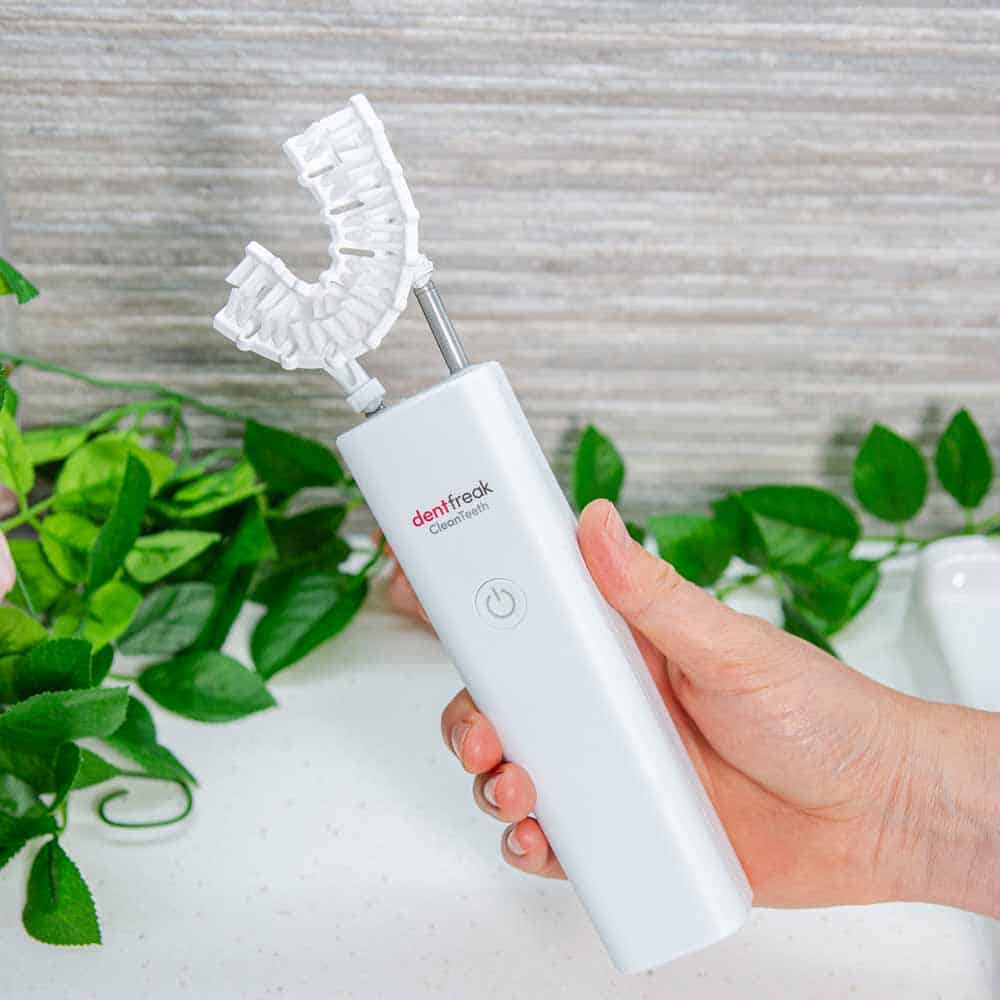
CleanTeeth cleaning results - before and after
To be totally honest, I was a bit worried about how well CleanTeeth would perform.
CleanTeeth’s own promotional videos clearly showed plaque left behind on the teeth after use. You don’t want this to happen.
I was then pleasantly surprised when my own testing resulted in far less plaque being left behind on the teeth than I had imagined. This is definitely a win for CleanTeeth here.
Such products do take some getting used to and my results did improve as I learned how the brush worked and how to best hold and angle the handpiece.
Whilst my testing and review is by no means a scientific test, to help demonstrate the results I use plaque disclosing tablets to highlight the plaque on my teeth.
The plaque is highlighted a pink/purple color by the disclosing agent. The aim of toothbrushing is to remove plaque.
The following images show before and after shots of my teeth when following CleanTeeth’s recommended brushing technique.
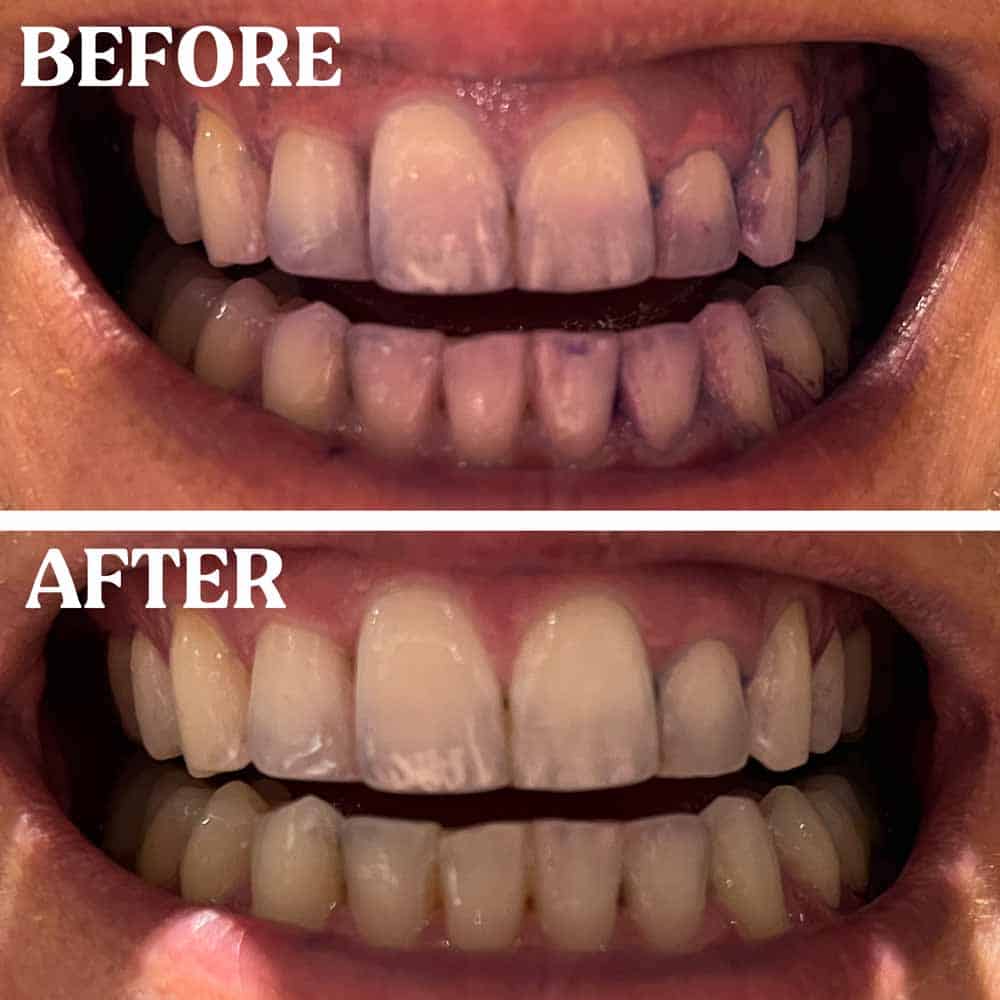
To me, it is clear that there is plaque left behind. You can see the residual purple along the gumline. But, I appreciate it isn’t necessarily obvious, so I have highlighted it in the following image.
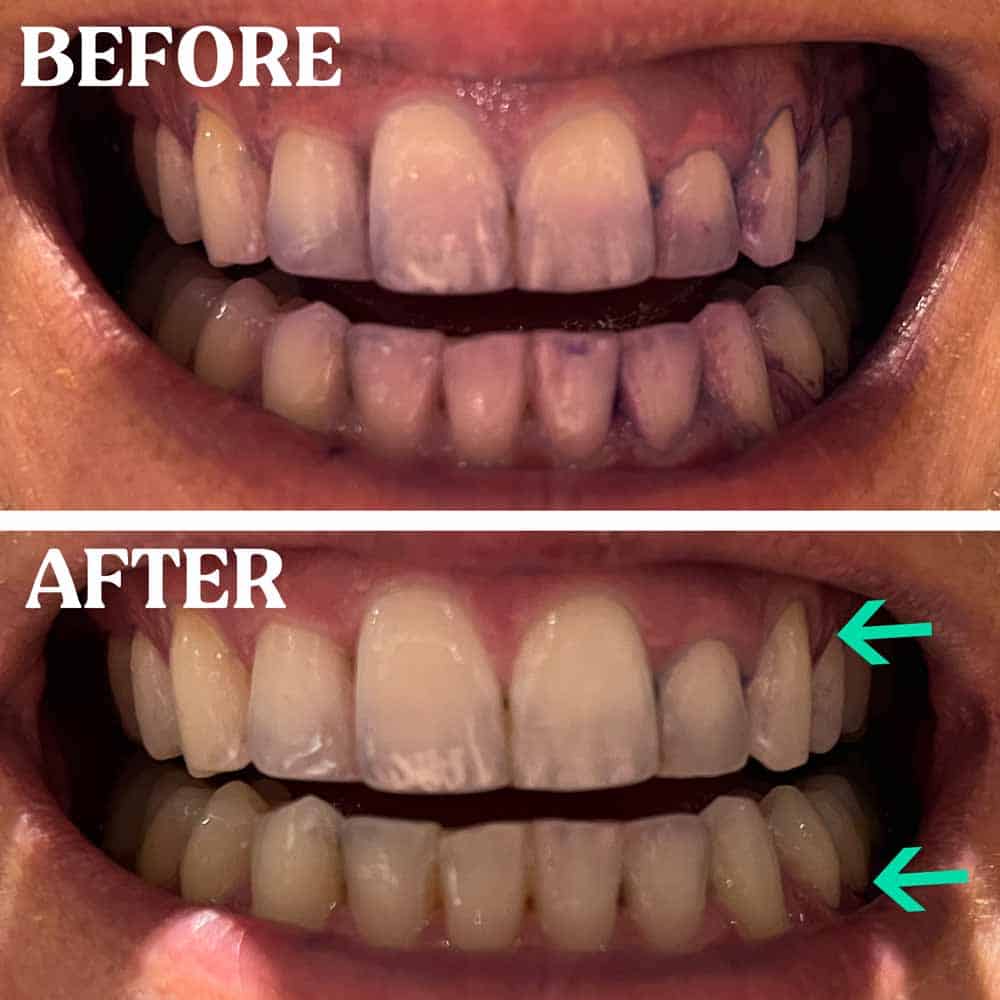
Given this is from just 40 seconds of brushing, these are pretty respectable results.
What I did notice is that there was more plaque left behind on the biting surfaces of my teeth than I had imagined.
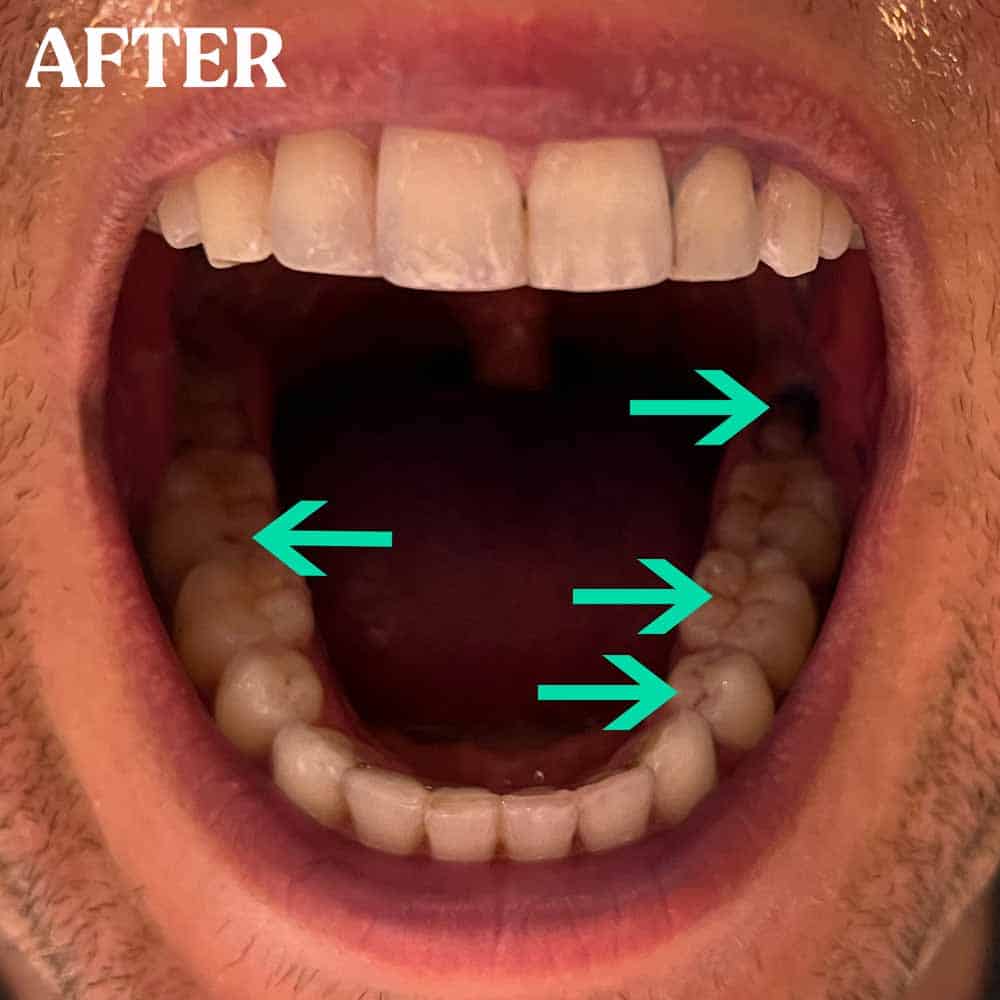
I don’t recall having as much left behind with the likes of SymplBrush.
When introducing a bit more of a wiggle and motion to the head as it moved I did note a visible improvement in the plaque removal results.
But again, still, some plaque was left behind.
Personally, I think this then puts this pretty much on par with what SymplBrush can achieve.
The only real caveat is that the cleaning of the top/biting surfaces of the teeth didn’t really appear to change all that much when I introduced more movement to the head. There was more plaque left here than there should be.
Here are some images with my adapted brushing approach.
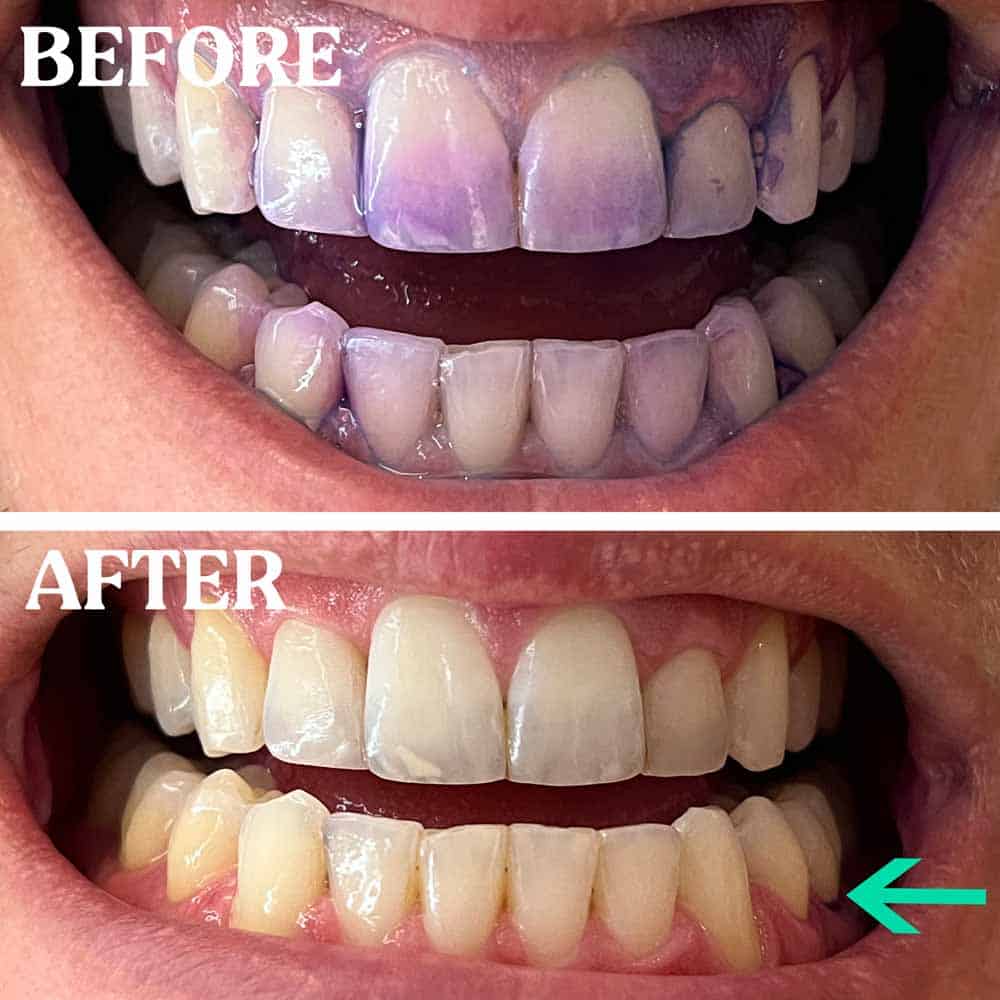
All told, still very good and these are areas that can be easily missed or not cleaned properly with a manual or electric toothbrush.
I did also find that if I were to brush for longer, the results were marginally better. However, I can’t necessarily say the results were significantly better. Brushing for twice as long didn’t appear to get twice the cleaning results. As an example, if the first brushing session got 90%, the second took that result to 92%.
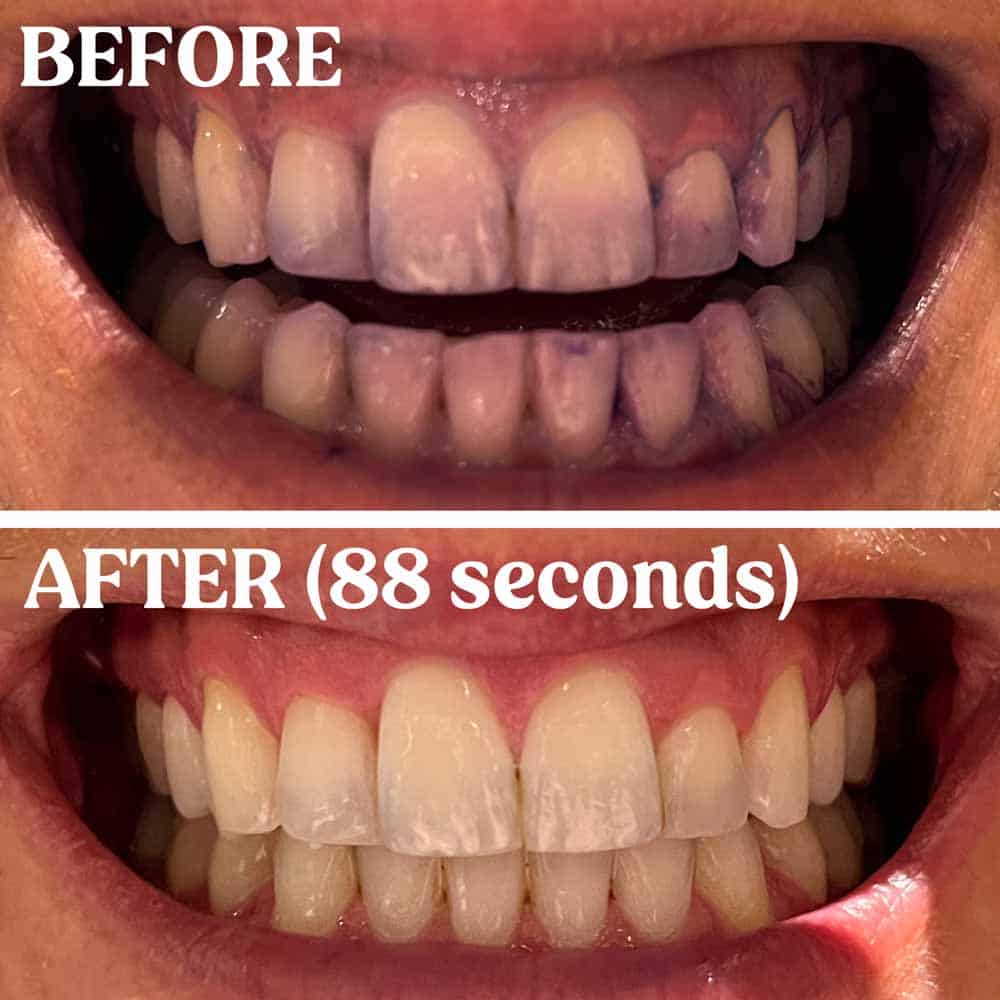
For this review, I have only tested on my own teeth, which are pretty neatly aligned after having Invisalign. How well it fares on crooked and crowded teeth is yet to be seen.
I suspect most mouthpiece toothbrushes would be similar, in that there will be areas that remain untouched or poorly cleaned as the bristles struggle to reach certain areas. But, the flexibility on this head does give me some hope.
Something not limited to CleanTeeth is the ability to reach and clean wisdom teeth, particularly those that are partially erupted.
I do have partially erupted wisdom teeth and upon inspection, it was very clear that these were outside of the reach of the bristles and brush head. There is always going to be a challenge with this sort of product when teeth have partially erupted, but it is a common issue so it’s something that needs consideration.
My testing is by no means scientific, but the images provide a good guide to what is possible with this product.
I do believe CleanTeeth does a respectable job. It is beaten marginally by SymplBrush, which cleans the teeth in 14 seconds less.
I would say that CleanTeeth does a better job at cleaning than Y-Brush – but then again, the cleaning time is about 4 times shorter with Y-Brush.
However, as you might expect, the results are not as good as a manual or electric toothbrush, used correctly for 2 minutes.
Within seconds of using an electric toothbrush after CleanTeeth, the spots missed were plaque free.
I do not advise switching to CleanTeeth as a replacement to the tried and tested manual and electric toothbrush. But, I do acknowledge that it can bring real improvements to someone not currently using the correct brushing techniques.
At the time of review, as far as I am aware, there is no clinical data or studies to support CleanTeeth.
This isn’t at all surprising given how new it is and the stage it is at, but it would have been nice if there were some more scientific data and conclusions to refer to.
According to CleanTeeth’s marketing materials, a number of dentists were consulted in the development process. These dentists do even appear in a video. This involvement is evident to a large extent in the finished product.
I am not wishing to disagree with Dr Dov Avrams who says ‘simplicity and efficacy is the name of the game, and CleanFreak does that flawlessly’, but I wouldn’t suggest it is flawless.
But perhaps I need to give myself a reality check here. The results are very good for the length of time spent brushing. And given few use the right technique or brush for the right amount of time anyhow, perhaps CleanTeeth would help to improve the oral care of some people.
The possible danger I can see here would be if people formed the belief that a product like this is perfect, or good enough that no extra effort is needed. If your dentist were to ask you to improve your brushing, if this is the only brush you have, you can’t. A manual or regular electric gives you the flexibility to move it more effectively to the areas of concern.
And ultimately, CleanTeeth is still technique sensitive. I do however admit that the technique is easier to master and remain consistent than other brushes.
Some people can benefit from CleanTeeth
Despite my criticisms, there are users who could really benefit from CleanTeeth today. For some, it could make significant improvements in their oral care.
Whilst there is no one size fits all, the people who can benefit most are those with disabilities and medical conditions that make toothbrushing with existing tools challenging.

For example, some people don’t have the dexterity to move a manual brush around the mouth. The way CleanTeeth works means this is less of an issue.
Others simply can’t do it themselves and require the assistance of others.
Of course, there are many different circumstances and we still advocate for traditional tools where possible, but CleanTeeth could potentially offer a lifeline for some people, particularly those with disabilities.
Our article dental care advice for people with disabilities looks at this topic in a bit more detail, if this is of interest to you.
And as I have intimated, if you currently struggle to brush twice daily for 2 minutes each time, you might be helped by DentFreak’s solution. It could potentially reduce the amount of plaque and clean the teeth better than you are doing so already.
The benefit is that it is covering more tooth surfaces at the same time and positions the bristles at ideal angles.
It will be of the biggest benefit to those whose total brushing time is 70 seconds or less per day.
But, this is not the solution.
Don’t buy CleanTeeth thinking you can get away with brushing for less time now and in the future. The goal is and remains to perfect your brushing technique and brush for the recommended time, with tried and tested tools.

It’s big and bulky in the hand
There is no denying that CleanTeeth makes a statement from the moment you get it out of the box.
Yes, it is very different from what most know as an electric toothbrush, but this is the heaviest and most bulky product of this type I think I have ever used.
Everyone I have shown it to has commented on how chunky it is.
It is certainly a larger and squarer design than most. It does taper a bit from the top to the bottom, but not much.
The edges are rounded, but this is far from the cylinder shape of most electric brushes.
It weighs a rather heavy 283g / 10 ounces.
It is 4.2cm / 1.7 inches wide and 4.1cm / 1.6 inches deep/thick.
It is the same height as most electric toothbrushes at about 24cm / 9.45 inches tall.
A ‘normal’ electric toothbrush weighs in at around 95-130g/3.4-4.6 ounces.
Therefore CleanTeeth is nearly 3 times as heavy.
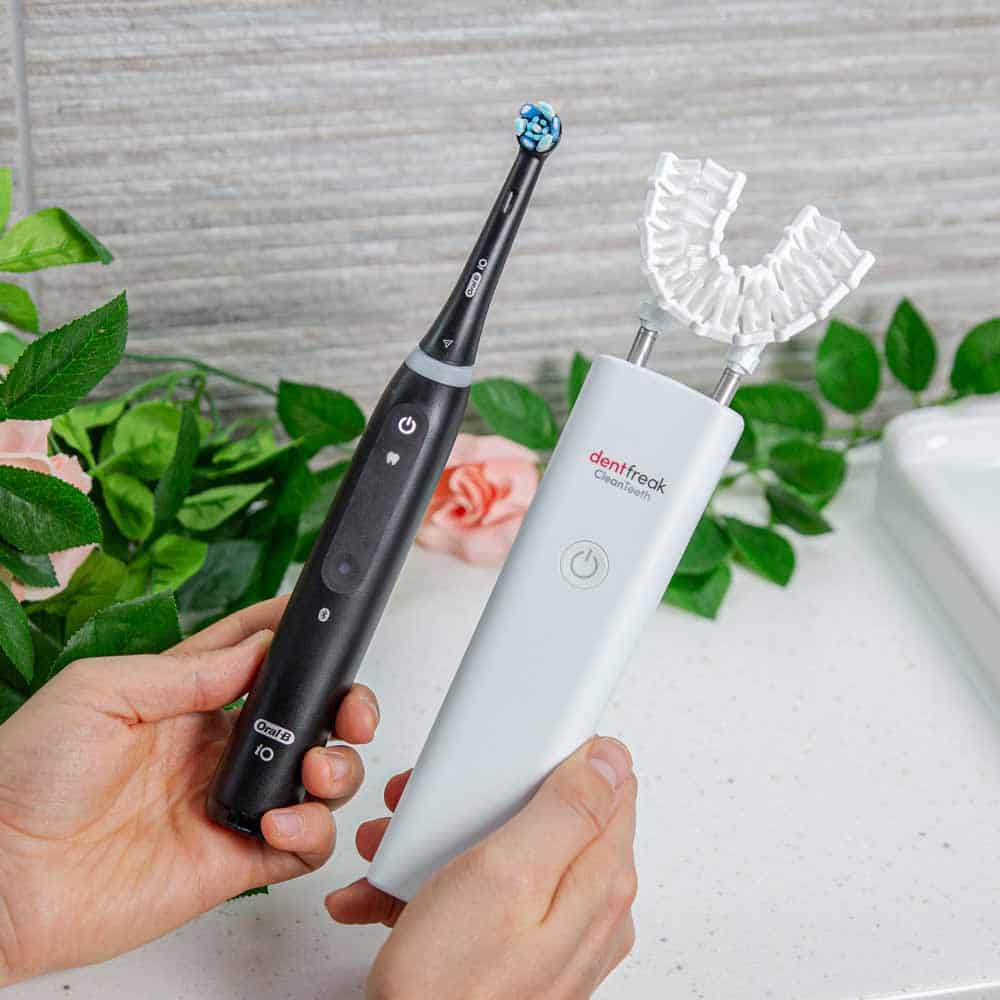
For the sake of comparison here are the weights of a few other brushes:
- SymplBrush - 95g/3.35oz
- Y-Brush - 77g/2.71oz
- TripleBristle - 141g/4.97oz
The weight is fairly balanced through the handpiece and I wouldn’t say it is unmanageable. But, I don’t understand why it is so heavy.
I have to presume it is all linked to the motor mechanism.
If you don’t travel much it isn’t necessarily an issue, it just doesn’t look as sleek as you might expect.
The base of the brush is flat so it stands upright on a countertop. Given its size and weight, it isn’t too easily knocked over.
There is just 1 button on the handle in the upper front half. This is the power button.
It has a very slight concave design to it and has a power icon shaped into it. It is clicky with a good amount of feedback.
A green or red light is emitted from the power icon and around the button subject to the level of power remaining in the battery.
The minimal design does mean the handle is relatively easy to keep clean. A rinse under the tap or a wipe with a cloth is fine.
The plastic handle is primarily a smooth touch finish. There are no raised grips or textured surfaces.
It is water resistant and can be used in the shower if you so desire. All the electrical components are sealed inside to protect against the water. It is IPX7 rated.

The brush head is adaptable
Where most toothbrushes have 1 shaft extending from the motor inside the handle, the way CleanTeeth works is that it requires 2.
It looks quite unusual and certainly makes it different from others.
And where most brush heads just push onto and pull off of the shafts, that isn’t quite the case here.
There are 2 arms (or legs, if you prefer) to the brush head that clip onto the attachments at the top of the metal shafts. You then need to twist the plastic locking screws to the locked position to securely fasten the head to the handle.
It is a bit more fiddly than most, but it works.
To remove you have to twist and unlock the screws and then pull the head off.
The silicone brush head or mouthpiece has 17 sections comprising of 13,250 bristles in total. Together these allow the brush head to take on a one size fits all approach. Or at least the vast majority. There are no alternative sized heads for men, women, or those with different sized mouths.
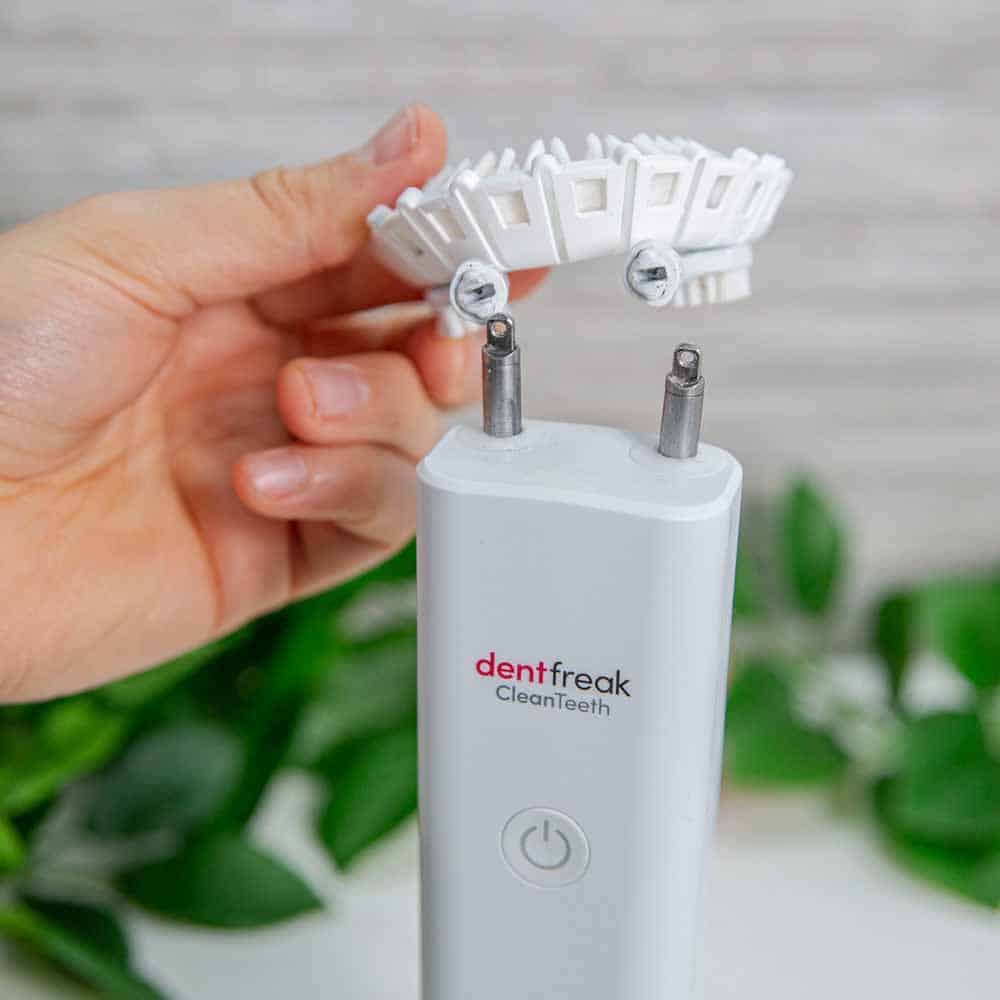
Other manufacturers have created different sized mouthpieces. What is the best approach is clearly up for debate, but what helps ensure this head fits a wider number of users is the way the whole thing flexes and adapts.
There are then 6 degrees of movement from the attachment on each metal shaft. Thus the whole mouthpiece can flex in and out to accommodate larger and smaller mouths.
DentFreak has used nylon bristles rather than silicone. These have proven their worth and are more effective based on the testing we have done with multiple products.
Each bristle is angled to meet the gum margin at 45 degrees. Whilst the majority of bristles are a typical sort of length for a brush head, some are longer and shorter subject to the teeth they are targeting in the mouth.
Rather unique are the 2 bristle pads on the back of the brush head. These sit at the top of the legs that attach to the handle.
Essentially what happens is that when in the mouth, these smaller pads are cleaning the biting surfaces of the teeth in the opposing arch.
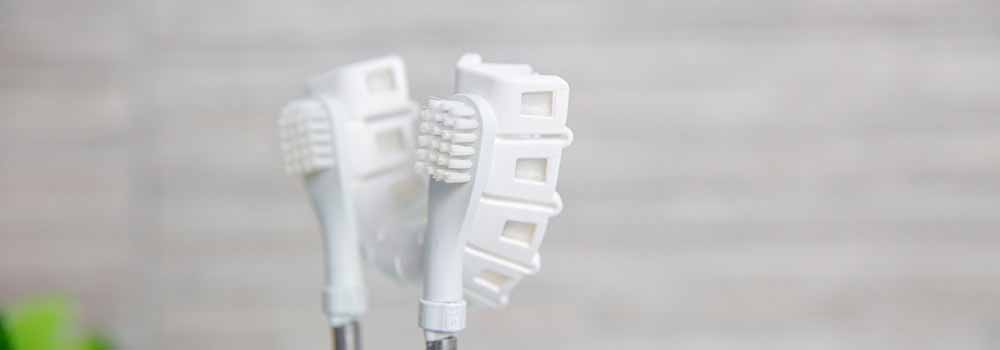
Adding to the adaptability of this brush is the way it actually moves.
The visuals included throughout explain this better than any text I can write. But, essentially, the head is covering around 12 teeth at any one time.
When you first put it in the mouth, it will be covering the front, back, and top surfaces of the front teeth. Your rear, molar teeth will not be covered.
When the brush is powered on, the mouthpiece is pushed and pulled along the teeth, moving to reach those molar teeth on either the right or left side of the mouth.
During any 22 second brushing session, the brush is moving back and forth along these teeth. Think of your teeth as a rail and the brush head is the train moving back and forth over it.
I would suggest I have a fairly typical sized mouth. I did have to open a fraction wider than I expected to have CleanTeeth fit. It aligned with my jaw much more comfortably than Amabrush.
And very importantly for me at least I didn't feel like it was jamming itself into the back of my mouth like Unobrush. Whilst it was quite large it wasn’t overbearing. A possible negative is that it didn’t clean my wisdom teeth well.
DentFreak suggests the head is suitable for anyone aged 14 and above.
A concern is that you could possibly be over brushing with CleanTeeth.
There are several factors to over brushing. There is the brushing too long and too often and then brushing with too much force.
Although CleanTeeth has no pressure sensor, the concern of too much pressure should not be an issue, because the mouthpiece doesn’t apply lots of force and the bristles are soft.
However, the amount of time or frequency of brushing could be.
With normal toothbrushing, each tooth surface is getting attention for just 1-2 seconds. Some, not all, teeth in this setup will be getting 22 seconds of attention. That is arguably too much.
The teeth affected most are the incisors and canines as these are at the front of the mouth.
The molars are unlikely to be overbrushed due to the fact that the head moves over and back of these relatively quickly during the cleaning cycle.
But, you will probably be ok if you are not using the brush more than twice a day.
How you actually brush with CleanTeeth
There is a correct technique for using CleanTeeth.
It is potentially less technique sensitive than a regular toothbrush, or at least it should be. But there are correct and incorrect ways to use it according to DentFreak.
Assuming the brush head is connected and the toothpaste applied, the steps are as follows:
- Step 1 - Place the toothbrush in the mouth over the teeth in the upper jaw.
- Step 2 - Turn the brush on and let it run through the 22 second cycle until it powers off automatically.
- Step 3 - Remove, turn over and place into the lower jaw.
- Step 4 - Turn the brush on and let it run through the 22 second cycle until it powers off automatically.
- Step 5 - Remove and rinse the brush head.
There are however a few tips to go alongside this:
- Make sure the bristles are over the teeth.
- When in either arch you can move the brush up and down just a bit to help the bristles reach the gum margins.
- For the lower jaw, the handpiece should be angled down ever so slightly, not perfectly horizontal.
- For the upper jaw, the handpiece should be pretty much horizontal most of the time.
- Don’t bite the brush head, just support it slightly with the opposing jaw.
As I mentioned before, I adapted this approach by wiggling it up and down, and adding small circular motions a bit to help achieve the best results. I am not saying that is best for everyone, but it is what appeared to work best for me.
Your head will shake when using CleanTeeth
The way the brush head moves does take some getting used to.
It sounds a bit extreme to use the word aggressive because it isn’t. But the motion of the brush head does cause your head to shake and wobble a lot more than a regular toothbrush or some of the other mouthpiece toothbrushes I have used.
Unobrush was probably the worst I have used, but CleanTeeth is quite vigorous.
It didn’t bother me that much and I certainly got more used to it the more I used it, but I still had a bit of a shake even after a couple of weeks of use.
Some will find this really off putting and won’t be able to tolerate it.
I can’t see a way of avoiding it. It is indicative of the mechanism used.
I will also note that the metal shafts do over time appear to build up some sort of black debris/grime on them. It stands out against the silver metal. It is far from a major issue, but I suspect it is a bit of grease or dust that builds up on them. It can be wiped off with ease. All being well this doesn’t pose an issue long term.
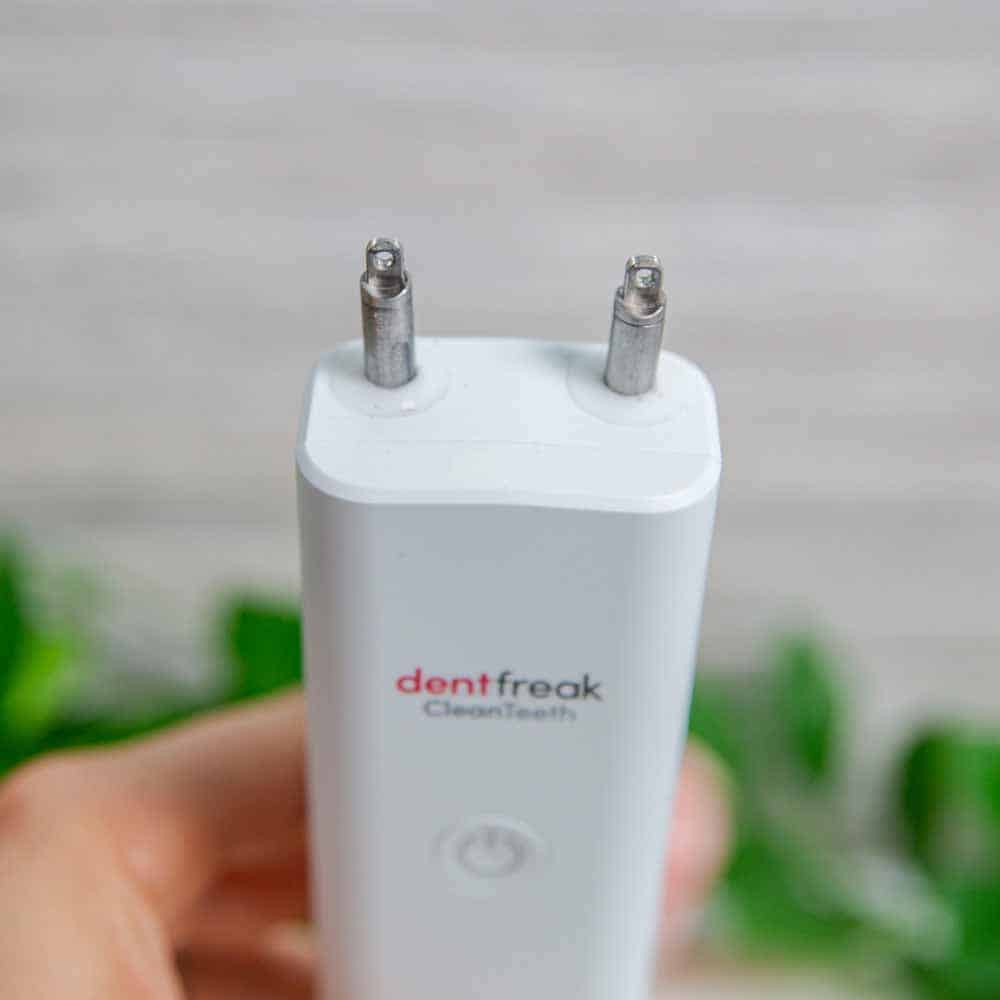
1 cleaning mode
There is little evidence that I am aware of that different cleaning modes of varying intensity and speed really make that much difference clinically. They appear to have more impact on a user's experience than how well they clean their teeth.
But they can also complicate daily use as users are not sure which mode to use when etc.
Having just 1 mode keeps things simple and this is exactly what we have here with CleanTeeth.
Press the power button to turn it on. Let it run through the 22 second cycle. Switch the arch of teeth and repeat.
It turns off automatically at the end of each 22 second session, making it clear it has finished.
The more simple and easier you use the better it often is.
There is no quadpacer because it isn’t necessary here like it is with regular electric brushes.
It’s a bit louder than you might expect
If you are used to the gentle hum of a sonic toothbrush, the CleanTeeth brush is a bit louder.
It is more on par with the oscillating and rotating brushes from Oral-B.
We registered 76 decibels so about 10-15 louder than most Philips Sonicare electric brushes.
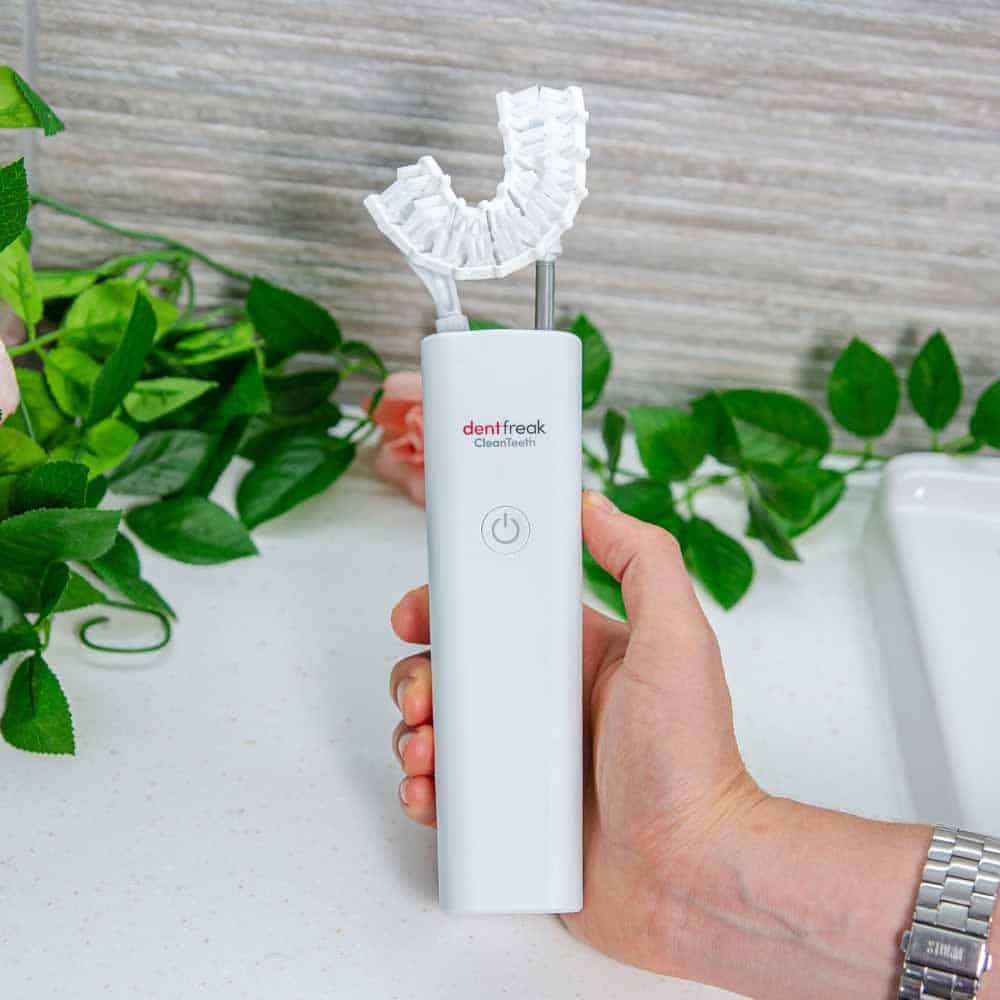
You use more toothpaste
I will be clear upfront in that this isn’t an issue exclusive to CleanTeeth, it presents itself with most mouthpiece toothbrushes.
The manufacturers recommend placing toothpaste in multiple locations. This allows a more even spread of paste across the bristles and the teeth.
In this instance, 3 locations are suggested.
The problem is that you are using about 3 times as much paste as you would use on a regular toothbrush.
It isn’t a huge issue, but you are going to in theory get through a tube of paste in much less time. It will cost you more.
And despite a flexible mouthpiece, I found that CleanTeeth still had some toothpaste residue clumped within the bristles, meaning some of the paste was wasted anyhow.
A workaround is to use a toothpaste tablet so the paste is already in the mouth and doesn’t need to be applied to the bristles.
A lack of accessories - regular travelers be aware
I have talked about how this is big and bulky. Not necessarily anything wrong with that, but if you want to travel light, this isn’t going to play ball. It is going to take up a good couple of hundred grams more of your weight allowance not to mention space in the bag.
Then there is the issue that there is no travel case available. So, unless you want to pop it in a wash bag or some plastic bag, the brush is going to be exposed to dirt and grime. And because there is no way to lock or protect the power button it could be accidentally activated.
Given the battery life is good and you would need repeated presses to run the battery down, it isn’t a big issue, just something to be aware of.
You could potentially remove and protect just the brush head only. It does come in a thin plastic box when it is shipped to you, but it isn’t designed to be a travel case for the bristles.
The provided USB charging stand is ideal for international travel and the 2 pin power adapter supports 100-240v.
Summary of design, usability, clean & general use
- Cleaning results are surprisingly good but some important areas missed
- Not a replacement for a regular manual or electric toothbrush
- CleanTeeth is suitable for some now, providing limitations are known
- Cleans all the teeth in 1 arch at the same time
- Cleaning lasts for 22 seconds per arch, 44 seconds in total
- The silicone mouthpiece is flexible with 17 individual sections and 13, 250 bristles
- 1 brush head size only
- Bristles are angled perfectly to help maximize cleaning results
- There is a correct technique for using the brush
- Better results are achieved by adapting the technique and increasing brushing time
- It is big, bulky, and heavy
- 1 cleaning mode only
- CleanTeeth is noisy at 76 decibels
- It will cause your head to shake when in the mouth
- You need to use more toothpaste than normal
- It is water resistant
- No travel case provided
The battery lasts at least 4 weeks
DentFreak suggests in the user manual that you get a usable battery life of about 4 weeks.
This is based on brushing for 30 seconds per time, twice a day.
I don’t think this is a bad battery life at all.
As noted earlier in the review, my brush was programmed to be just 15 seconds per cleaning cycle, thus 30 in total.
Updates do mean that CleanTeeth now requires 2 x 22 second cycles. With this in mind, theoretically, the usage time could be a bit less.
However, from my testing, I really don’t think this will be the case.
The minimum I generally like a brush to achieve is around 2 weeks.
That said, a normal toothbrush is operating for 120 seconds per use, not 44 seconds.
Therefore, it could be argued that CleanTeeth should actually last 3 times as long because the brushing time is a third of a usual 2 minute routine.
I achieved a staggering 280 brushing sessions of 15 seconds in length.
Crunching the numbers to account for the 22 second cycles, you could potentially get somewhere in the region of 76 days from the battery. This is nearer 3 months!
But, our battery tests are not carried out by placing the brush in the mouth. Therefore the resistance and power needed to move the bristles along the teeth might have an impact on the battery.
It simply isn’t practical for me to conduct a real-world test of this.
I do suspect the 4 weeks usage time will be easily achieved and likely surpassed.
Are the batteries the cause of the bulky handle?
I want to just reiterate how the handle is quite bulky when you consider comparable products. It is also weighty too.
I don’t know what is responsible for this. It could well be the motor mechanism, it could be the batteries or a combination of them both.
DentFreak does not document the capacity of the batteries inside the handle. To be honest, few do. But, based on the size and weight, I don’t think it would be unfair to expect a really excellent battery life.
If other users get the same results as I did, then maybe it is well worth it.
For those interested, it is Lithium-Ion (Li-Ion) batteries that are used.
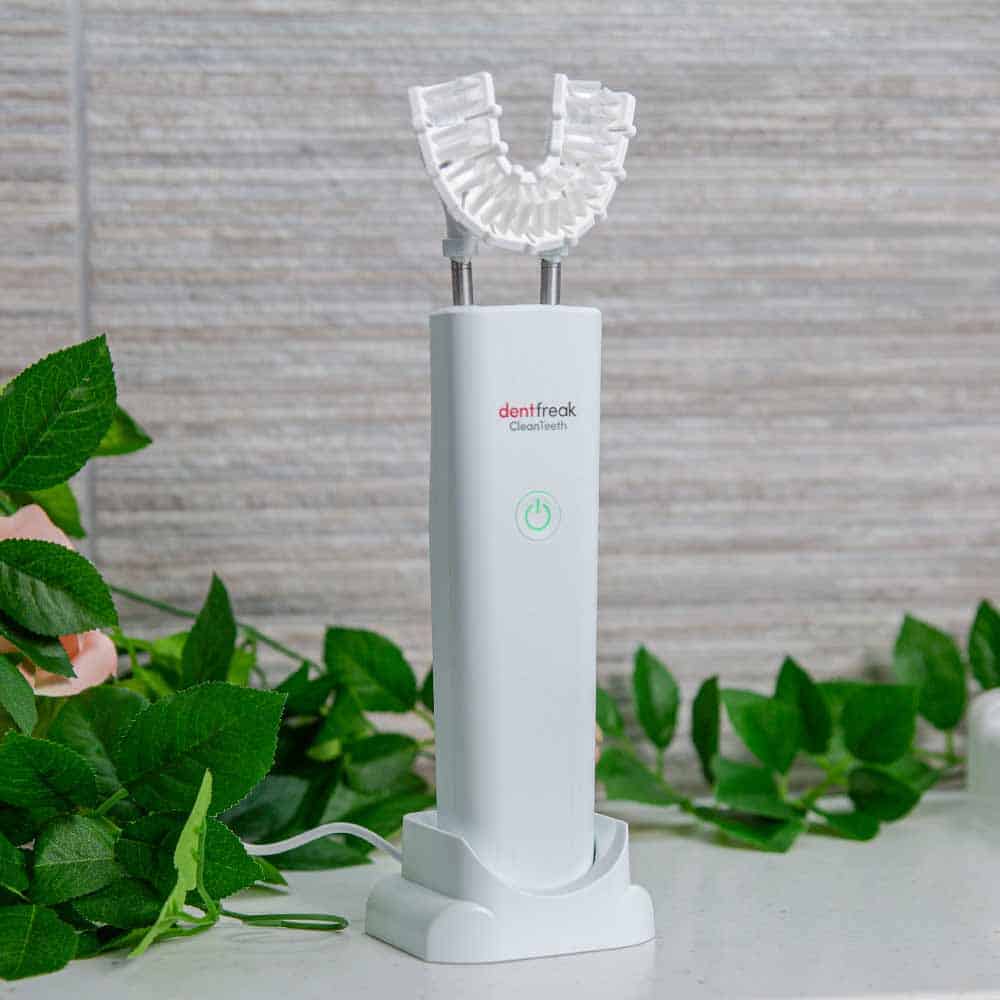
It is supplied with a USB charging stand
Included in the box is a charging stand for CleanTeeth.
It is a basic rectangular-shaped charger that has a flat base with raised sides to hold the brush fairly securely. The hands-on images best demonstrate how the right and left side of the stand extend slightly further out, presumably for design and stability.
The base is pretty much flat with the exception of 4 slightly raised elements to give a very slight lift and presumably resistance when placed on a countertop.
The handle charges wirelessly, like the vast majority of electric toothbrushes.
Coiled wire in both the charging stand and the handle transfers a charge through the plastic body, doing away with the need for a cable to be physically connected to the handle itself.
Extending from the back of the stand is a white colored cable (to match the handle and the stand). The cable has a male USB type A connector at the end.
This cable is not removable from the stand itself.
It is a little shy of 60cm/2 feet in length. This is a bit shorter than most charging cables.
Included in the box is a 2 pin USB power adapter. Rated to support 100-240v this allows you to connect the USB stand to a wall mounted power outlet, if you desire.
The USB adapter is pretty much identical to that you get with many smartphones and other gadgets. You don’t have to use this adapter that comes in the box. Arguably it could have been excluded because most have one already. It would be better for the environment too.
That said, many would suggest that it should be included given the price.
Color changing LED
When the brush is placed on the charger, the power icon will pulse red to indicate the handle is charging.
Once the battery is fully charged, it turns green.
It can take up to 24 hours to fully charge CleanTeeth.
The handle can get a little warm when on charge, this is normal. CleanTeeth also recommends keeping it fully charged and on the charger when not in use.
As you use the device, the battery will be depleted. Whilst the charge levels are good, the power icon on the power button will be lit green. When the power is lower, it will turn to a red color to help notify you.
The battery is not user replaceable
The battery has been sealed inside the handle to protect against water ingress and ultimately your safety.
DentFreak never suggested they were aiming for sustainability or that it would be replaceable in any way.
This approach is commonplace with such products, so I am not calling them out here specifically.
In an ideal world, for longevity, some simple method of replacement would be good as batteries do fail from time to time with repeated charges.
There are no details within the documentation on how to safely remove the batteries for disposal.
Summary of battery life
- Rechargeable lithium-ion battery built-in
- Suggested to last approximately 4 weeks on a full charge
- Achieved 76 days (10+ weeks) in my hands-on testing
- USB charging stand included
- Charging cable is a bit shorter than expected
- 2 pin USB plug adapter in the box
- It can take up to 24 hours to charge
- The charging stand supports 100-240v
- LED power icon changes color to show the battery charge status
Price & where to buy
I have included links to buying options here at the start of the review.
In the section below, I discuss the price more generally and in relation to similar products.
A good electric toothbrush will typically cost you under $70, when taking into account the normal discounts on retail prices.
You can then expect to be paying somewhere in the region of $20-30 per year for replacement brush heads.
Therefore over a 3 year period, you are looking at a total cost of somewhere between $125 and $150.
When a toothbrush is designed to brush your teeth in less time, you probably expect you are going to have to pay a premium.
The premium you are prepared to pay might well be different from somebody else.
CleanTeeth costs $199.
Replacement brush heads are sold in packs of 2 at $35 ($17.50 each).
Over 3 years, you are looking at a cost of $392.
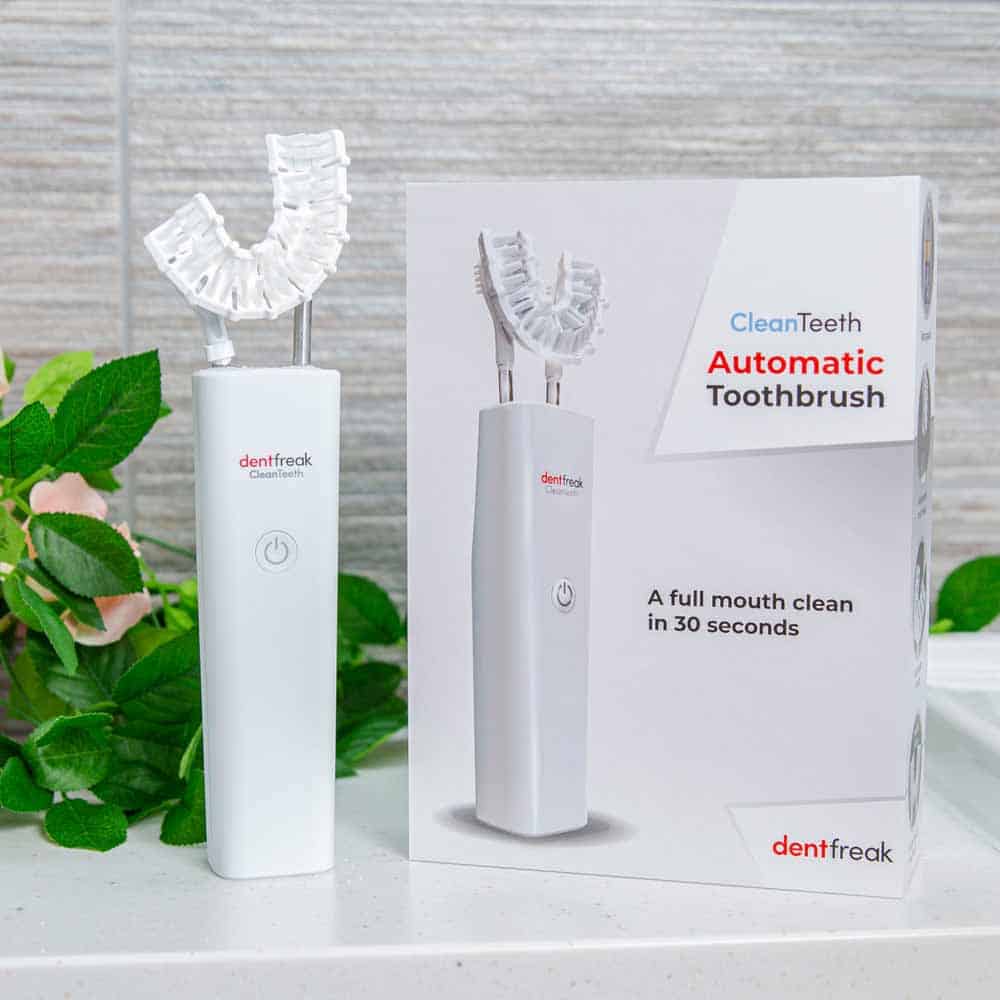
By toothbrush pricing standards, this is pretty expensive. It certainly falls into what I would classify as the ‘premium’ price tier and is around 3 times more expensive than a decent regular electric toothbrush.
It does allow you to brush your teeth in a third of the time, so maybe that is justifiable.
But, given the results are not quite as good as you can achieve with a regular electric brush, is it?
Now to be fair, CleanTeeth might come down in price and there may well be some discounts to be had. But as it stands we don’t have any data to confirm this.
For those, like us who backed this on the crowdfunding platforms, we did enjoy a discount.
In the interest of transparency, we paid $119. We did have to take the chance on the product and wait 2 years to get it.
I have mentioned a few times the competitors that CleanTeeth has, most notably Y-Brush and SymplBrush.
SymplBrush launched with a retail price of $160 whilst Y-Brush cost $143.
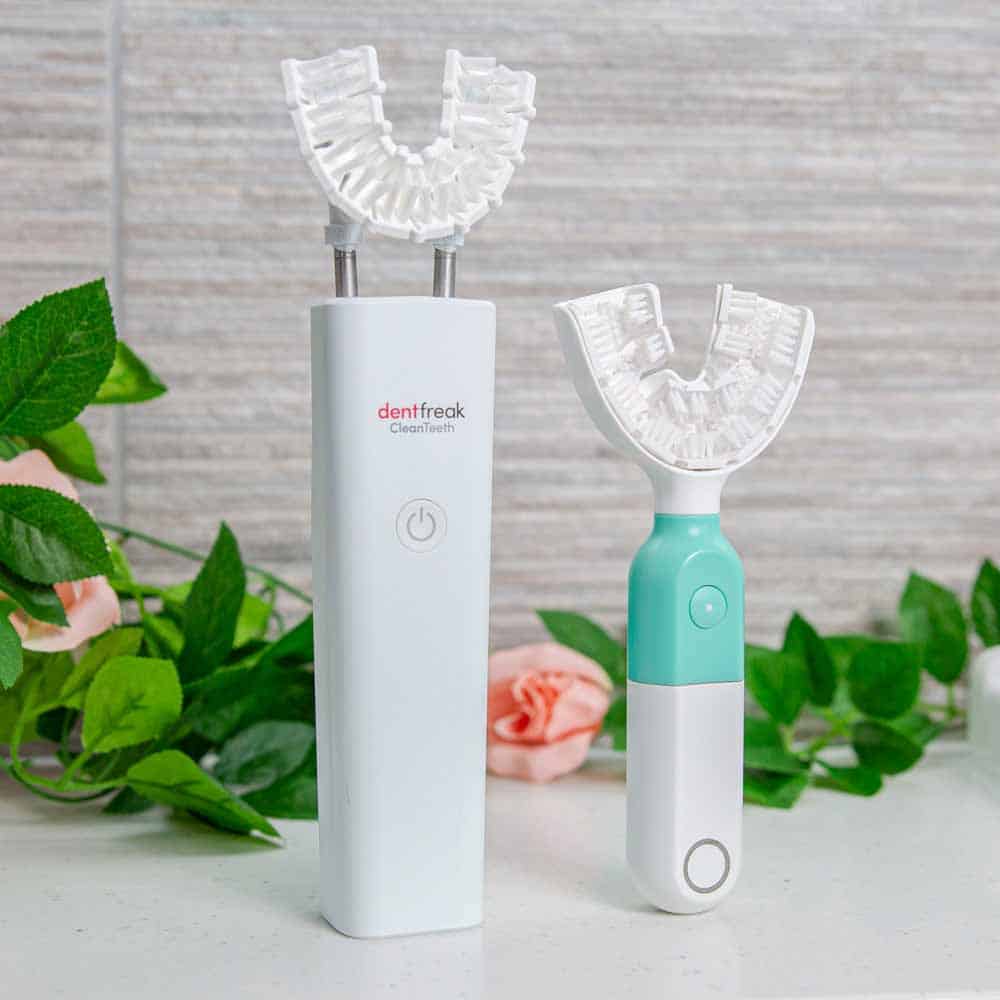
Some time on from their initial introduction, both companies have since updated their pricing and now they are $150 and $80 respectively. That is a fair saving to be had with both, most notably with Y-Brush.
There is more to it than price alone, but Triple Bristle costs around $70 and cleans the teeth in 40 seconds like CleanTeeth. 30 Second smile costs around $130.
With the price of the competition in mind, I do think to be competitive CleanTeeth needs to come down to sub $150 and realistically $120.
Please note that all prices quoted are approximates and will vary based on location, supplier and time of purchase. These figures were correct at the time of writing and should not be relied upon as hard fact, but used as a guide during your decision process.
Summary of price & where to buy
- List of buying options included here
- Recommended retail price of $199
- Replacement brush heads cost about $17.50 each - sold as a 2 pack for $35
- Works out at $392 over 3 years
- Other mouthpiece toothbrushes are cheaper
- Typical good electric toothbrushes cost a third of the price
My thoughts on reliability and repairability
As a new company producing their first toothbrush, we have no prior experience to guide us on what the reliability of this toothbrush will be like.
Most companies as part of their design process cater for many uses and try to ensure that components will stand the test of time.
Although I have been testing it for a few weeks for the purpose of this review, I am not in a position to put it through comprehensive stress testing.
The handle feels durable and well built.
There is a seam around the handle where 2 parts of the plastic casing have been put together which could potentially pose a problem, but no obvious issues exist at the time of review.
Because the brush charges wirelessly, there are no external ports to be concerned about.
A concern I do potentially have is the ease with which the 2 metal arms glide in and out of the body of the handle over time.
I wonder whether these might need greasing. I have noticed a black substance (maybe grease) that has appeared on them over my time using it. This does wipe off.
You do get a 1 year warranty, which is ok, but not great really when you consider most products like this come with a 2 year warranty. You are paying quite a high price too.
There is little information on the support process and how issues will be dealt with.
Unfortunately, no parts on the brush are designed to be user serviceable. This isn’t uncommon for an electric toothbrush. With a need to move to more sustainable approaches this is disappointing.
Environmental impact
A mouthpiece or automatic toothbrush like CleanTeeth is still ultimately an electric toothbrush. Unfortunately, electric toothbrushes don’t fare well in their impact on the environment.
This doesn’t mean that you shouldn’t use one. You need to balance effective cleaning and disease prevention against the environmental impact.
Electric toothbrushes can reduce the need for dental treatment. And avoid the need for planetary impacts that come from procedures such as fillings.
There is a lack of detailed evidence to confirm that a filling is worse than the use of an electric toothbrush. But, with the data available, dentist Gemma Wheeler believes that a single filling is worse than an electric brush with a usable life of 5 years.
There is no perfect solution as yet. We want to see manufacturers doing more to tackle this issue and achieve significant improvements.
Schemes to recycle brush heads only scratch the surface of what needs to be done.
Related to the CleanTeeth specifically:
Pros
- Recyclable cardboard box.
Cons
- The inner tray within the box is plastic but should be recyclable.
- 2 pin USB power adapter is not necessarily needed - many have these already.
- No user serviceable parts.
Conclusion
My experience with mouthpiece and automatic style toothbrushes to date has been very mixed, with the vast majority failing to get anywhere close to the standards required.
CleanTeeth thankfully is one of the better choices. I was pleasantly surprised with the cleaning results.
But as with rival products, there are still areas of the mouth that are not cleaned as well as they should be. Hence, our recommendation is really to stick with a regular manual or electric toothbrush and use it correctly.
There is a place for CleanTeeth and I am certainly not writing it off.
You could use this within your oral care routine if you understand the limitations and are prepared to pay the price.
But, I do think SymplBrush and Y-Brush are more desirable products. They are not as heavy or bulky and more pleasant to use. And they are a bit cheaper too.
A possible good alternative solution is TripleBristle. Like CleanTeeth, it can brush the teeth in 40 seconds. It is different from a regular electric toothbrush and more affordable. But, all things considered, regular brushes are the gold standard.
If there is ever CleanTeeth version 2 I would be keen to try it.
Size guide
- Toothbrush height with head - 24cm / 9.5 inches
- Toothbrush height without head - 19cm / 7.5 inches
- Width - 4.2cm / 1.7 inches
- Depth/thickness - 4.1cm / 1.6 inches
- Weight with head - 283g / 10oz
- Weight without head - 265g / 9.4oz
- Package weight - 696g / 24.6oz
Noise
- 76dB
Country of manufacture
- China



